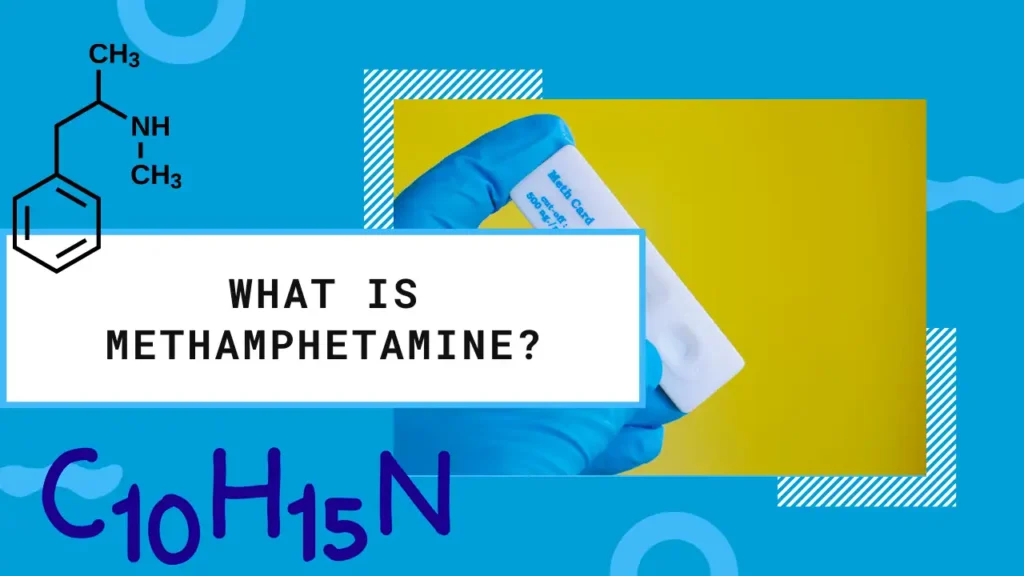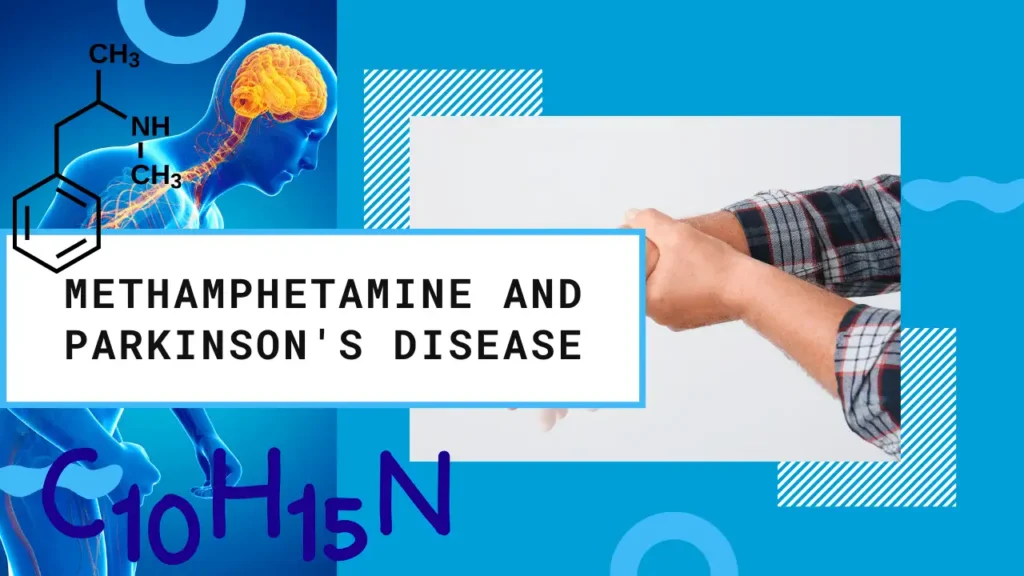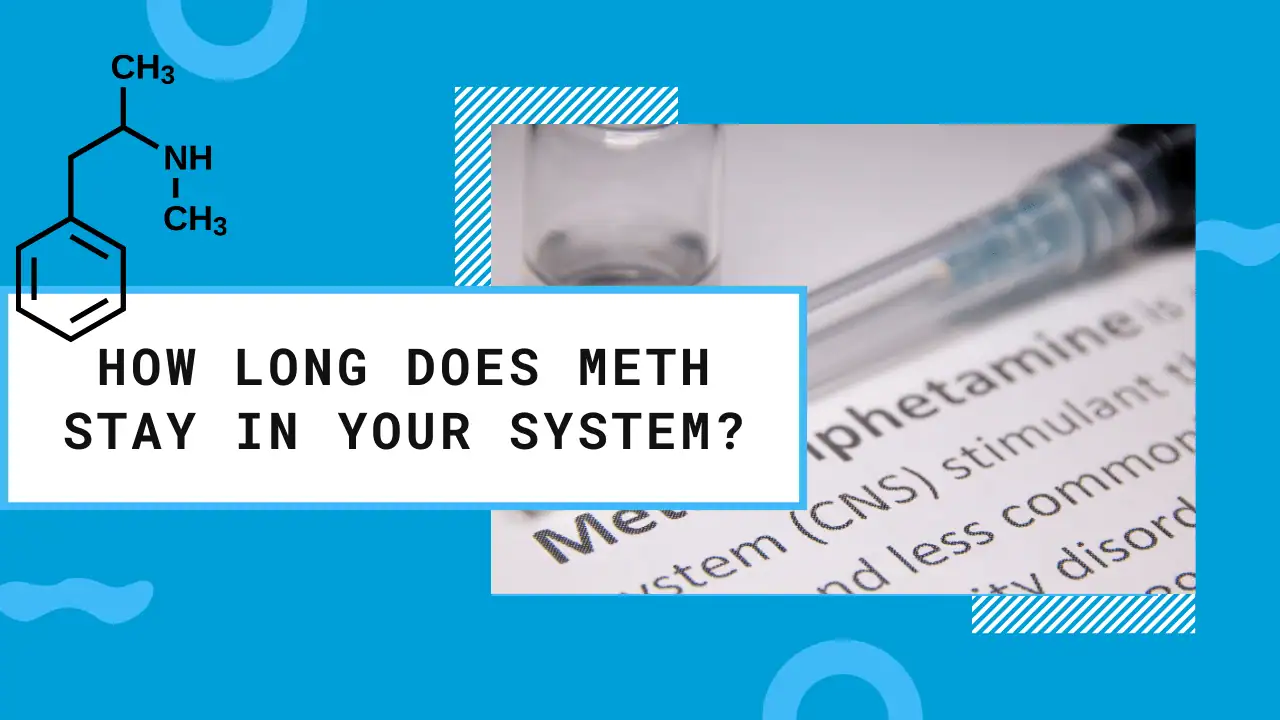Methamphetamine, commonly known as meth, is a potent stimulant that can have lasting effects on your body. Understanding how long it stays in your system is vital, especially for those undergoing drug testing. Different tests measure the presence of meth metabolites in varying parts of your body such as urine, blood, and hair, each with its detection window.
What is Methamphetamine?

Methamphetamine, often shortened to meth, is a powerful, highly addictive stimulant that affects the central nervous system. Methamphetamine is typically a white, odorless, bitter-tasting powder that easily dissolves in water. The drug was developed early in the 20th century from its parent drug, amphetamine, and was initially used in nasal decongestants and bronchial inhalers.
Meth’s effect is much more potent, longer-lasting, and more harmful to the central nervous system than its parent drug. Usage of this substance can lead to severe physical and mental health issues, including addiction. As a potent stimulant, methamphetamine increases the amount of natural chemicals such as dopamine in the brain.
Dopamine plays an important role in body movement, motivation, and reinforcement of rewarding behaviors. The drug’s ability to rapidly release high levels of dopamine in reward areas of the brain strongly reinforces drug-taking behavior, making the user want to repeat the experience.
Methamphetamine and Parkinson’s Disease

Is Methamphetamine good for Parkinson’s?
While methamphetamine is recognized as a dangerous and addictive substance, some research points to potentially beneficial effects for Parkinson’s disease. Parkinson’s disease is a neurodegenerative disorder characterized by a deficiency of dopamine in the brain.
As stated earlier, methamphetamine causes a significant increase in dopamine levels, leading some to consider its potential therapeutic applications. However, this is a complex and highly controversial area of study due to the severe side effects and addictive properties of the drug.
It is important to note that while methamphetamine does increase dopamine, it does so in a way that is harmful and unsafe overall. Using methamphetamine to self-medicate for Parkinson’s disease could lead to a host of additional health problems, including addiction and severe damage to the brain and body.
Therefore, methamphetamine is not recommended as a treatment for Parkinson’s disease. It is crucial to seek professional medical advice for the management of Parkinson’s disease or any other health condition.
The Way It’s Used
Methamphetamine can be consumed in various ways, including smoking, snorting, injecting, or even ingesting orally. The method of use plays a significant role in how long the drug stays in the system. For instance, smoking or injecting meth introduces it directly into the bloodstream, leading to an immediate, intense “rush” and quicker absorption by the body. On the other hand, snorting or oral ingestion results in a slower onset of effect and may stay in the system longer.
Is It Prescription or Illicit?
While methamphetamine does have a medical use and can be legally prescribed (known as Desoxyn), it’s more commonly used illicitly. Prescription methamphetamine is typically in the form of a pill, while illicit versions are often crystal-like or powdered substances. Prescription meth is regulated, and dosages are monitored, decreasing the likelihood of a toxic buildup in the body. Illicit meth, however, is often “cut” with other substances and can vary in purity, leading to unpredictable effects on the body and how long it stays in a person’s system.
Overall Health
The overall health of the individual also determines how long meth stays in their system. People with healthy liver and kidney functions are likely to eliminate meth from their systems faster than those with impaired organ function. Similarly, hydration levels, body mass index, and age can all influence how quickly meth is metabolized and eliminated.
Rate of Metabolism
Each person’s metabolism is unique and can greatly influence how long meth remains detectable in the body. A faster metabolism will break down meth more quickly, reducing the duration it stays in the system. Conversely, those with slower metabolisms may retain meth metabolites for a longer period, increasing the window of detection. Physical activity and diet can also impact metabolic rates. Regular exercise and a healthy diet can boost metabolism, potentially shortening the time meth is detectable.
Understanding Meth Duration

How Long are the Effects of Meth?
The effects of methamphetamine vary depending on the dose and method of administration. Immediately after intake, users experience a rush of euphoria, increased energy, and hyperactivity. These acute effects typically last for 6 to 8 hours. However, some residual effects, like insomnia and decreased appetite, can persist for several days post-use. For an in-depth understanding.
Meth Half-Life
The half-life of a drug refers to how long it takes for half of the drug to be eliminated from the body. Meth has a relatively long half-life for a stimulant, approximately 10 to 12 hours. This means that it could take more than two days to entirely clear a single dose of meth from your body.
Factors That Influence How Long Meth Stays in Your System
Several factors can influence how long meth remains in your system. These include the dose taken, frequency of use, and the individual’s metabolic rate, overall health, and body mass. For instance, regular, heavy meth use can result in the drug being detectable for a longer period compared to a single use.
How Long Does It Take to Get Addicted to Meth?
Meth addiction can occur at varying speeds, largely depending on the frequency of use, method of intake, and individual predisposition towards addiction. Some users may develop an addiction after a few uses, while others may take longer. It’s critical to remember that meth is highly addictive and use can quickly lead to dependence and addiction. Those struggling with meth use should seek professional help, such as SAMHSA’s National Helpline.
Detection in Different Systems
How Long Does Meth Stay in Urine?
Methamphetamine is mostly excreted through urine. After intake, meth can be detected in urine within 2 to 5 hours and remains detectable for about 3 to 5 days on average. However, for heavy or chronic users, meth can be found in urine for up to a week. It’s important to note that these durations can vary depending on factors such as the individual’s metabolism, overall health, and the amount and frequency of meth use.
How Long Does Meth Stay in Blood?
In blood, meth can be detected within 2 to 4 hours after use and it typically stays in the bloodstream for 1 to 3 days. However, this can be extended in the case of heavy users, who may show traces of meth in their blood for up to a week.
How Long Does Meth Stay in Saliva?
Meth can be detected in saliva within 10 minutes to 24 hours after use. It remains detectable in saliva for about 1 to 2 days, making saliva tests a good option for detecting recent meth use.
How Long Does Meth Stay in Hair?
Hair follicle tests can detect meth use for a longer period compared to other methods. After use, meth can take 7 to 10 days to enter the hair. Once in the hair, meth can be detected for up to 90 days. This makes hair follicle tests a powerful tool for identifying long-term meth use.
It’s crucial to remember that these timelines are average estimations and can vary significantly from person to person. Factors such as frequency of use, dosage, metabolism, and overall health can influence these timeframes. If you are struggling with meth use, don’t hesitate to reach out to professionals such as SAMHSA’s National Helpline for assistance.
Routes of Administration
Meth can be administered in several ways, each with varying impacts on how quickly it enters the bloodstream and how intense the effects can be. The common methods include smoking, snorting, injecting, and oral ingestion.
- Smoking: This is the most common method of meth use. The drug reaches the brain almost immediately when smoked, resulting in an intense but short-lived high.
- Snorting: Snorting meth can lead to a less intense but longer-lasting high compared to smoking. The effects are felt within 3 to 5 minutes of administration.
- Injecting: Injecting meth, usually dissolved in water, leads to a rapid and extremely intense high. The effects are felt almost immediately, but this method carries a high risk of overdose and infectious disease transmission.
- Oral Ingestion: Swallowing meth in pill form results in a slower onset of effects, usually felt within 20 minutes to an hour. This method tends to produce a less intense high.
Is Meth Combined With Other Substances?
Meth is often combined with other substances, either to enhance its effects or to mitigate the side effects. Common combinations include meth and alcohol, heroin, or marijuana. Combining meth with other substances, known as polydrug use, significantly increases the risks and potential harm. It’s crucial to understand that mixing meth with other substances can lead to unpredictable effects and can be extremely dangerous.
Binge and Crash Phenomenon
Methamphetamine is notorious for its “binge and crash” pattern of use. This refers to a cycle where users consume large quantities of meth over a short period to maintain the high, followed by a drastic crash.
Binge and Crash
During the binge phase, users repeatedly consume meth, often foregoing sleep and food to maintain their high. This can last for several days and is characterized by hyperactivity, wakefulness, and increased focus. However, as the effects begin to wear off, the crash phase sets in. The crash phase is marked by extreme fatigue, depression, and increased appetite. The severity of the crash often drives users to consume more meth, thus perpetuating the cycle. This pattern of use can quickly spiral into addiction, making methamphetamine a highly dangerous drug.
Frequency of Use
The frequency of meth use varies from person to person. Some users may engage in meth use sporadically, while others may use it multiple times in a day to prevent the onset of the crash phase. Frequent use, especially via methods that deliver the drug quickly to the brain, such as smoking or injection, significantly increases the risk of addiction. In addition, frequent meth use can also lead to serious health consequences such as heart disease, stroke, and damage to the teeth and skin, among others.
Withdrawal and Detox
Meth Withdrawal
Meth withdrawal is the body’s reaction to the absence of methamphetamine after a period of regular use. When someone stops using meth, their body has to readjust to functioning without the drug, leading to several withdrawal symptoms.
Meth Withdrawal Symptoms
Meth withdrawal symptoms can be highly unpleasant and, in some cases, life-threatening. These symptoms begin to manifest as soon as the effects of the drug wear off and can last for up to two weeks. Symptoms may include intense cravings, anxiety, fatigue, depression, psychosis, and suicidal thoughts.
Phases of Withdrawal
Meth withdrawal typically occurs in two phases: the acute phase and the subacute phase. The acute phase begins within the first 24 hours after the last use and can last up to 10 days, characterized by extreme cravings and depression. The subacute phase follows and can last up to three weeks. During this phase, symptoms gradually decrease in intensity.
How to Get Meth Out of Your System
The most effective way to eliminate meth from your system is to stop using the drug and allow your body to process and excrete it naturally. Drinking plenty of fluids, eating a healthy diet, and getting regular exercise can help expedite this process. However, professional medical intervention is often necessary, especially for chronic users.
Methamphetamine Detox and Withdrawal
Managing meth withdrawal and detoxification should be done under medical supervision in a professional detox facility. This ensures the individual is safe and comfortable during the withdrawal process. Medical professionals can administer medications to alleviate withdrawal symptoms and provide emotional support during this challenging time. Detox is the first step towards recovery and should be followed by comprehensive treatment to address the underlying issues associated with meth use.
Impact and Consequences
What are the Implications of Second-Hand Meth Smoke?
Second-hand meth smoke can have detrimental effects on those exposed to it, particularly children. Exposure can occur through inhaling airborne particles or through contact with contaminated surfaces. Symptoms may include headaches, dizziness, and nausea, while long-term exposure can lead to more severe health problems such as respiratory issues and developmental problems in children. It’s important to be aware of these risks and to take protective measures when necessary.
Consequences of Meth Addiction
Meth addiction can have devastating consequences on an individual’s health, relationships, and overall quality of life. Health-wise, it can lead to severe dental problems, cardiovascular diseases, and potential brain damage. Socially, meth addiction can strain relationships with family and friends, possibly leading to isolation. Furthermore, the economic implications are significant, with individuals often facing job loss and financial instability. Importantly, meth addiction can also have legal consequences, as possession, use, and distribution of meth are illegal activities. These consequences highlight the importance of seeking help and treatment for meth addiction. Organizations like SAMHSA can provide the necessary support and guidance.
Remember, meth addiction is a serious issue that requires immediate attention. If you or someone you know is struggling with meth use, do not hesitate to reach out to a healthcare professional or local support group.
Seeking Help
Has My Drug Use Become a Problem? Self-Assessment
If you’re questioning whether your drug use has become a problem, it’s vital first to acknowledge this concern as a significant first step. It can be helpful to perform a self-assessment, honestly evaluating your behaviors and feelings related to meth use. Some questions to consider are: Do you feel the need to use the drug regularly? Do you use more meth to achieve the same high? Do you experience withdrawal symptoms when you stop using? Do you neglect responsibilities due to your drug use? If you answered ‘yes’ to any of these questions, it may indicate that your meth use has become a problem. It’s important to seek professional help if you’re experiencing difficulty with substance use.
Getting Treatment for Meth Addiction
Treatment for meth addiction typically involves a multipronged approach consisting of detox, therapy, and aftercare. Detox is the initial step, helping you physically rid your body of meth. Once detox is complete, therapy can help you understand the root causes of your addiction, providing strategies to cope with cravings and prevent relapse. Cognitive-behavioral therapy and contingency management interventions are among the most effective treatment methods for meth addiction. Aftercare is an essential aspect of maintaining long-term recovery and may involve continued therapy, support groups, and lifestyle modifications. Remember, recovery is an ongoing process, and it’s never too late to seek help.
Reach Out For Help
If you’re struggling with meth use, know that you’re not alone, and reaching out for help is a sign of strength. Many resources are available to provide support, including healthcare providers, therapists, and support groups. Organizations like the Substance Abuse and Mental Health Services Administration provide a 24/7 helpline for immediate assistance. Reach out to someone you trust about your struggles or directly contact a professional. Remember, the journey to recovery begins with a single step.
Conclusion
Methamphetamine addiction is a serious and complex issue, with wide-ranging impacts on an individual’s health, relationships, and overall well-being. However, it’s essential to remember that no matter how severe the addiction, recovery is always possible. A comprehensive treatment approach that includes medical detox, therapy, aftercare, and ongoing support can help individuals overcome this addiction. As with any journey, the path to recovery begins with the first step of acknowledgment and seeking help. It’s never too late to reach out for assistance, and numerous resources are available to provide support. Remember, you’re not alone in this fight, and seeking help is a testament to your strength and resilience.
Frequently Asked Questions (FAQs)
- What is Methamphetamine?
Methamphetamine, commonly known as meth, is a highly addictive stimulant drug that affects the central nervous system. It can be smoked, snorted, injected, or orally ingested.
- What are the signs of meth use?
Signs of meth use can include increased energy and focus, reduced appetite, euphoria, increased respiration, and rapid or irregular heartbeat.
- What are the health risks associated with meth use?
Chronic meth use can lead to a variety of health issues, including dental problems, weight loss, mental health issues, and damage to the heart and brain.
- What is second-hand meth smoke and its effects?
Second-hand meth smoke refers to the exposure to methamphetamine smoke by non-users. Exposure can lead to headaches, dizziness, and nausea. Long-term exposure may cause respiratory issues and developmental problems in children.
- What are the consequences of meth addiction?
Meth addiction can have detrimental effects on an individual’s health, relationships, and financial stability. It may lead to severe health problems, strained relationships, job loss, and legal troubles.
- What does meth addiction treatment involve?
Treatment for meth addiction typically involves detox to rid the body of the drug, therapy to understand and manage the addiction, and aftercare for ongoing support.
- Where can I get help for meth addiction?
You can reach out to healthcare providers, therapists, and support groups. Organizations like SAMHSA provide a 24/7 helpline for immediate assistance.






